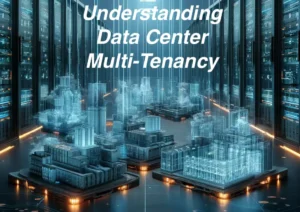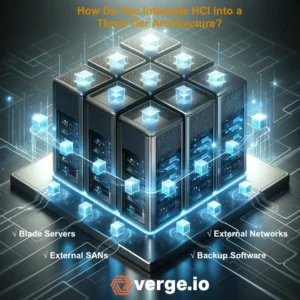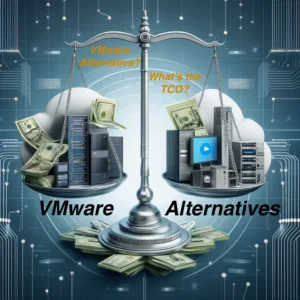The impending Broadcom acquisition, ever-increasing prices, and stalled innovation have many customers wondering how to calculate the ROI of a VMware Exit. There are several factors to consider when calculating the return on investment of a VMware Exit:
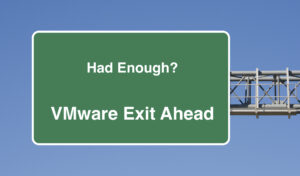
- What is the cost difference in software?
- What additional hardware is required?
- How much effort is there in conversion?
- Are there any other residual savings?
The Software ROI of a VMware Exit
The primary motivation for looking for a VMware alternative is saving money, and the software license cost is at the top of the list. VMware pricing is both expensive and is increasing. Many VMware customers indicate that their renewal price will increase, and they fear that the renewal rate will increase further once the Broadcom acquisition is complete.
VMware pricing is also complex. There are multiple modules to purchase, and there are classifications within those modules based on the number of CPUs and cores in each node within the cluster. The documentation on the VMware site about licensing is rather lengthy, and each separate module (VSAN, NSX, etc…) needs a separate license. Determining the exact price of a VMware license is a challenge partly because of this complexity and partly because it seems each customer gets a different price.
VergeOS, an Affordable VMware Alternative
Even before the price increases and uncertainty of the Broadcom acquisition, customers were flocking to VergeOS because of its efficiency and simplicity. The VergeOS pricing model is simple. It is per node, regardless of each node’s number of processors, cores, RAM, or storage capacity. It typically is less than half the price of VMware. VergeIO also has a five-year price lock option, so not only is there a fast ROI, but there is also the added benefit of pricing stability.
The Hardware Required for a VMware Exit
Many vendors require you to buy new hardware as you make your VMware exit, even if the servers supporting the current environment are more than up to the task. They may need more powerful hardware to run their hypervisor, or they may not support the hardware you are using today, especially if it is more than a few years old. Buying new hardware significantly increases the time it takes to realize an ROI.
Most infrastructure software (hypervisor, storage, and network) is inefficient. These solutions convert the stacks to software but layer them on top of each other instead of integrating them into a singular code base. The layering only increases their inefficiency and complexity.
VergeOS, A Model of Efficiency
VergeOS completely integrates the infrastructure rotating it 90° into a single linear plane. The tight, efficient code base can abstract more performance and capacity from the existing server hardware. Once switching to VergeOS, most organizations can, using the same hardware, increase the number of workloads and even virtualize workloads previously deemed bare-metal-only.
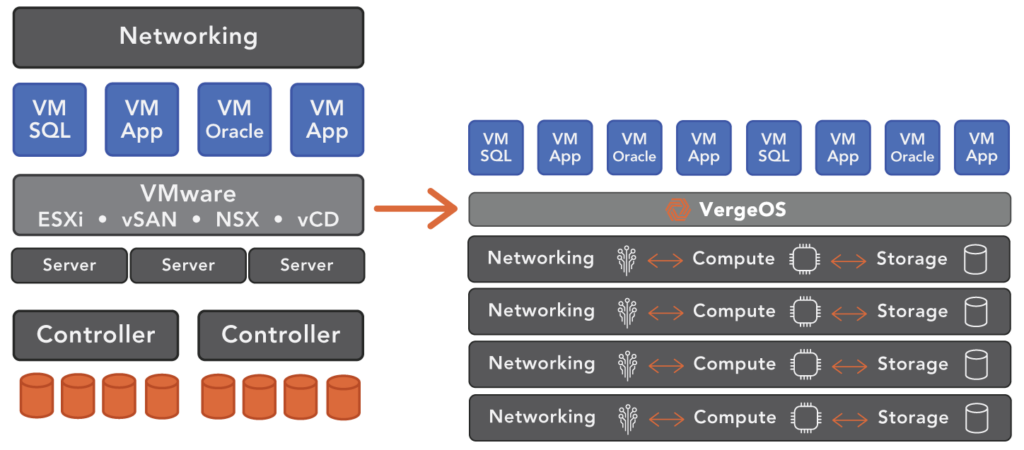
Leveraging the existing server hardware delivers a positive return on investment much faster than solutions that must replace the server hardware. Extending the life of the existing server hardware also means that the customer can delay the next round of server upgrades, further accelerating ROI.
The Effort of a VMware Exit
One of the most significant considerations when calculating the ROI of a VMware exit is how difficult it is to switch from VMware to the new platform. Also critical is determining what resources are required to do so with minimal time and disruption. While some alternative hypervisors have some form of VMware import, they require that you pause the VMware environment as you convert one VM at a time. Then you must keep VMware “paused” while testing the converted VMs and workloads. The process is slow and requires far too lengthy application outages.
VergeOS, Seamless Migration
VergeOS enables you to migrate your VMs from VMware while they are still running. Our IOmigrate capability leverages change block tracking (CBT) to update the Verge OS VMs incrementally. You can use this method to extensively test your VMs in the VergeIO environment until you are satisfied that everything will work as planned. Many customers will first use VergeIO as a disaster recovery option until they are ready to cut over to VergeOS completely.
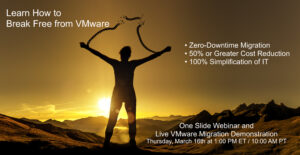
Please register for our one-slide webinar, which will include a live demonstration of a VMware to VergeOS migration. It is live on Thursday, March 16th, at 1:00 PM ET / 10:00 AM PT.
The Post VMware Exit – Experience
Another consideration when calculating the ROI of a VMware exit is what is the experience of operating post-VMware exit? Does the new infrastructure software include capabilities not available before? The reality is that most infrastructure alternatives are sold primarily on price rather than capabilities. These vendors scramble to market using unoptimized open-source code. As a result, the customer gains little in switching to the new platform.
VergeOS, A Superior Experience
VergeOS not only provides a dramatic reduction in costs, but it also provides superior value infrastructure capabilities. As stated above, the VergeOS can run more workloads on less hardware. It also can support mixed nodes, so you can support the needs of a variety of different workloads and can scale from one to one hundred nodes.
VergeOS also delivers a superior storage services portfolio, including:
- Global Inline Deduplication
- Silent Corruption Detection & Correction
- WAN Optimized Remote Synchronization
- Storage Multi-Tiering
- High Performance – up to one million IOPS per node
- AES 256-bit encryption
- Instant, Immutable, Unlimited Snapshots & Cloning
VMware, without the introduction of NSX, provides little networking functionality beyond a virtual switch. VergeOS includes a full complement of networking capabilities, including:
- Layer 2 and 3 networking
- Firewall and DNS servers
- Network Address Translation & Port Address Translation (NAT/ PAT)
- Quality of Service (QOS)
- Static Routing
- DHCP (Client and Server)
- Authoritative DNS
- Port Mirroring (North/South) & (East/West)
An Exit Worth Taking
VergeOS is not only a way out of the uncertainty of VMware. It is a superior platform for your data center. It will dramatically lower today’s costs, extend the life of existing hardware for years, and better position you to adopt and adapt to future technology. At the same time, you will experience a massively simplified IT operations experience that is even superior to the public cloud. With VergeOS the ROI of a VMware exit is quick and long-lasting.
